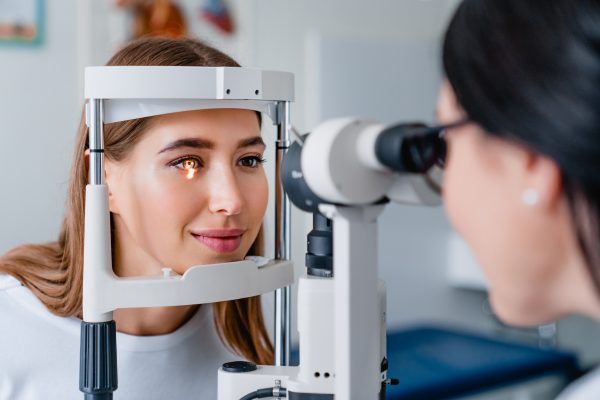LASIK, or laser assisted in situ keratomileusis, is an outpatient ophthalmic procedure where a highly skilled ophthalmologist / surgeon uses laser energy to create a LASIK flap and re-shape the cornea (the clear bubble of tissue at the front of the eye where one might place a contact lens).
By definition, LASIK involves, as a primary step, creation of a disk-shaped “flap” of corneal tissue that the ophthalmologist would lift and separate from the surrounding tissue prior to proceeding to the next steps. The flap is hinged such that it doesn’t completely separate from the surrounding tissue, and allows for proper orientation when finishing the procedure.
As the cornea is comprised of five distinct cellular layers, a premise of the procedure is surgeon access to the layer of cells that just happens to be sandwiched right in the middle. This cellular layer is called the stroma, and creation of the flap allows for such access.
Prior to more technological advances in LASIK, the corneal flap was created by a mechanical instrument called a keratome. A keratome featured a small housing, called the keratome head, that moved across the cornea on a geared track. The keratome head contained a small surgical blade that oscillated at upwards of 15,000 RPM – thereby making a small incision on the cornea and creating the flap.
However, on an “all laser” protocol, no such bladed instrument is used. Oh, the surgeon still requires access to the stroma, and there’s still a flap created…but it’s all done with laser energy! The advantages of an all-laser approach are many, with the two most noteworthy advantages being patient peace of mind (who wants to think “eye surgery” and “blade” in one single thought??) and greater surgeon control over flap thickness. While true that there were some flap thickness variations or options with a keratome, they were limited. With a laser-created flap, the attending surgeon can adjust flap thickness by as little a 5 microns. Also, he or she may choose to create a custom flap, where the flap’s hinge is located laterally rather than superiorly, or the flap’s shape is elliptical rather than round. Think “1974 VW Beetle” vs “2000 Jaguar XJ8.” Both cars will get you from Point A to Point B. Both cars are pretty cool – but only one of them is really cool.
Femtosecond Laser
A femtosecond laser used to create corneal flaps uses a YAG laser (the most commonly-used laser in ophthalmology) operating in the infrared wavelength to produce ultrashort pulses of energy to create adjacent areas of microcavitation (separation of tissue at the molecular level) at a specified depth in the cornea. The bubble created leaves a cavitation volume of 2 to 3 cubic µm. Thousands of these tiny bubbles, created in a raster pattern across the cornea, define the interface plane between the flap and the stromal bed. Bubbles are then stacked, starting around the edge of the interface, proceeding up through the epithelium to the corneal surface, creating the side cut and completing the flap creation.
If it sounds super-high tech, it’s because it is! This higher-tech approach to LASIK flap creation yields a far lower risk of flap complications, both intra- and post-procedurally, and, again, affords the attending surgeon far greater control over flap parameters. Some studies have shown that post-procedure visual outcomes are even more favorable by virtue of all-laser LASIK when compared to keratome-created LASIK flap cases.
All-Laser LASIK, Bladeless LASIK, and Other Similar Terms:
When researching LASIK, you will find many different terms or brands are used to describe the same procedure. For example, All-Laser LASIK and Bladeless LASIK refer to the same type of LASIK procedure where no microkeratome (blade) is involved. Other names for the All-Laser LASIK procedure include brands such as: IntraLase, iLASIK® or IntraLASE.® These are not different types of procedures; rather, these terms are brands of bladeless LASIK using a Femtosecond laser to create the flap and an Excimer laser to correct vision. IntraLase was the first Femtosecond laser approved by the FDA in 2001, thus making it possible for LASIK surgeons to begin performing All-Laser LASIK.
Benefits of All-Laser LASIK:
There are some advantages to choosing a bladeless LASIK procedure. With computer-guided control, Femtosecond lasers allow surgeons to better customize the creation of the corneal flap for individual patients. The enhanced accuracy of the surgical process makes it possible to create flaps with even thickness and structure. In doing so, there is less risk of a flap problem. For example, a non-uniform flap contour may induce new astigmatism after LASIK.
The precision of a Femtosecond laser also allows surgeons to refine the corneal flap with optimal architecture and flap edge contour. A beveled edge enables the Femtosecond flap to fit more securely in its original position at the end of the LASIK procedure. A more secure flap edge means faster healing for patients and less risk of a flap problem like displacement.
Many patients are naturally nervous about the idea of a blade being used on their eye during the LASIK procedure. If this is so, All-Laser LASIK can provide peace of mind for patients choosing to proceed with LASIK.
We do hope you’ll schedule your complimentary LASIK consultation with us today here at The LASIK Vision Institute. Please don’t forget to ask for a tour of our treatment suite!

Find a LASIK Surgery Location Near You
We’re located nationwide – it’s easy to find a LASIK Vision Center near you.
_____________________
References:
Creating LASIK Flaps: Femtosecond Laser vs. Mechanical Microkeratome. (2007, July 1). American Academy of Ophthalmology. https://www.aao.org/education/current-insight/creating-lasik-flaps-femtosecond-laser-vs-mechanic
Johnson & Johnson Vision. (2016). History of refractive surgery. Retrieved from https://www.jjvision.com/sites/default/files/media_center/History_of_Refractive_Surgery.pdf
Kim, J.Y., et al. (2006). A femtosecond laser creates a stronger flap than a mechanical microkeratome. Retrieved
from https://iovs.arvojournals.org/article.aspx?articleid=2163686
Thompson, V. (2019). Bladeless LASIK: Femtosecond laser eases LASIK fears. Retrieved from https://www.allaboutvision.com/visionsurgery/intralasik.htm
Categories:



